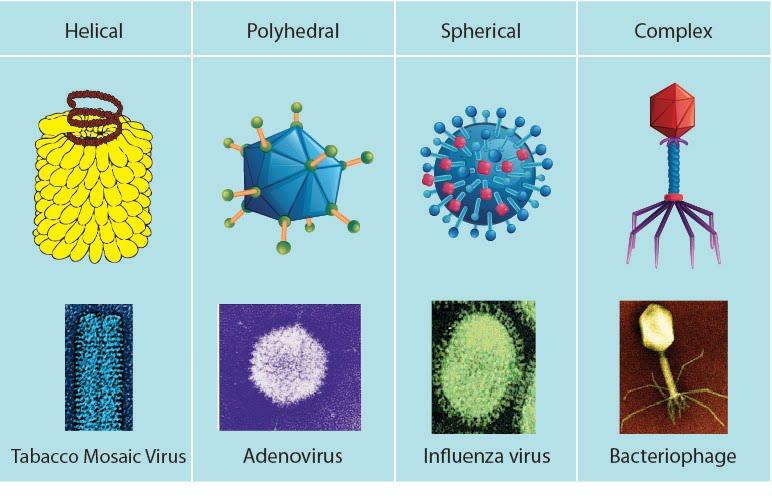
Describe the types of viruses on the type of the host cell and give their economic importance.
Answer
557.4k+ views
Hint: There is a wide range of viruses that infect humans and other animals, some causing genuine diseases and others not. It’s come in numerous types and has a wide scope of impact. Some make us sick for a day or two preceding disappearing, while others are lifelong. Some are a minor inconvenience, while others, such as Ebola, can cause life- threatening complications.
Complete answer:
- Viruses can be classified into 3 kinds on the basis of the type of host:
1) Animal viruses:- Those viruses which infect animals and cause various diseases. For example, Retrovirus.
2) Plant viruses:- Those viruses which infect plants. For example, the Tobacco Mosaic Virus.
3) Bacteriophage:- Those infecting bacteria. For example, Temperate phages.

- The virus contains the characteristics of both living and non-living organisms so they can be utilized in the field of biotechnology.
- Bacteriophage destroys bacteria thus is used in water preservation as it keeps the water fresh.
- Bacteriophage helps in recycling carbon in the marine environment.
- Virotherapy utilizes viruses as vectors to treat different diseases, utilized in the treatment of cancer and gene therapy.
- The virus contains various proteins, therefore, it can be used in the production of proteins such as vaccines, antigens, and antibiotics.
- Viruses are fundamentally responsible for the quick destruction of harmful algal blooms.
Some animal-infecting viruses, including the hepatitis C virus, talked about above, are known as oncogenic viruses: They have the capacity to cause cancer. These viruses interfere with the typical regulation of the host cell cycle either by either presenting genes that stimulate unregulated cell development (oncogenes) or by interfering with the expression of genes that repress cell development.
Plant viruses can be transmitted by an assortment of vectors, through contact with an infected plant’s sap, by a living organism, for example, insects and nematodes, and through pollen. At the point when plant viruses are transferred between various plants, this is known as horizontal transmission, and when they are inherited from a parent, this is known as vertical transmission.
Note: Viral replication inside a living cell consistently creates changes in the cell, at times bringing about cell death and sometimes gradually killing the infected cells. Plant viruses can genuinely disrupt crop growth and development, fundamentally influencing our food supply. They are responsible for poor crop quality and quantity worldwide and can achieve huge economic losses yearly. Different viruses may harm plants utilized in landscaping.
Complete answer:
- Viruses can be classified into 3 kinds on the basis of the type of host:
1) Animal viruses:- Those viruses which infect animals and cause various diseases. For example, Retrovirus.
2) Plant viruses:- Those viruses which infect plants. For example, the Tobacco Mosaic Virus.
3) Bacteriophage:- Those infecting bacteria. For example, Temperate phages.

- The virus contains the characteristics of both living and non-living organisms so they can be utilized in the field of biotechnology.
- Bacteriophage destroys bacteria thus is used in water preservation as it keeps the water fresh.
- Bacteriophage helps in recycling carbon in the marine environment.
- Virotherapy utilizes viruses as vectors to treat different diseases, utilized in the treatment of cancer and gene therapy.
- The virus contains various proteins, therefore, it can be used in the production of proteins such as vaccines, antigens, and antibiotics.
- Viruses are fundamentally responsible for the quick destruction of harmful algal blooms.
Some animal-infecting viruses, including the hepatitis C virus, talked about above, are known as oncogenic viruses: They have the capacity to cause cancer. These viruses interfere with the typical regulation of the host cell cycle either by either presenting genes that stimulate unregulated cell development (oncogenes) or by interfering with the expression of genes that repress cell development.
Plant viruses can be transmitted by an assortment of vectors, through contact with an infected plant’s sap, by a living organism, for example, insects and nematodes, and through pollen. At the point when plant viruses are transferred between various plants, this is known as horizontal transmission, and when they are inherited from a parent, this is known as vertical transmission.
Note: Viral replication inside a living cell consistently creates changes in the cell, at times bringing about cell death and sometimes gradually killing the infected cells. Plant viruses can genuinely disrupt crop growth and development, fundamentally influencing our food supply. They are responsible for poor crop quality and quantity worldwide and can achieve huge economic losses yearly. Different viruses may harm plants utilized in landscaping.
Recently Updated Pages
Master Class 12 Business Studies: Engaging Questions & Answers for Success

Master Class 12 Economics: Engaging Questions & Answers for Success

Master Class 12 English: Engaging Questions & Answers for Success

Master Class 12 Maths: Engaging Questions & Answers for Success

Master Class 12 Social Science: Engaging Questions & Answers for Success

Master Class 12 Chemistry: Engaging Questions & Answers for Success

Trending doubts
What are the major means of transport Explain each class 12 social science CBSE

Which are the Top 10 Largest Countries of the World?

Draw a labelled sketch of the human eye class 12 physics CBSE

How much time does it take to bleed after eating p class 12 biology CBSE

Explain sex determination in humans with line diag class 12 biology CBSE

Differentiate between homogeneous and heterogeneous class 12 chemistry CBSE




